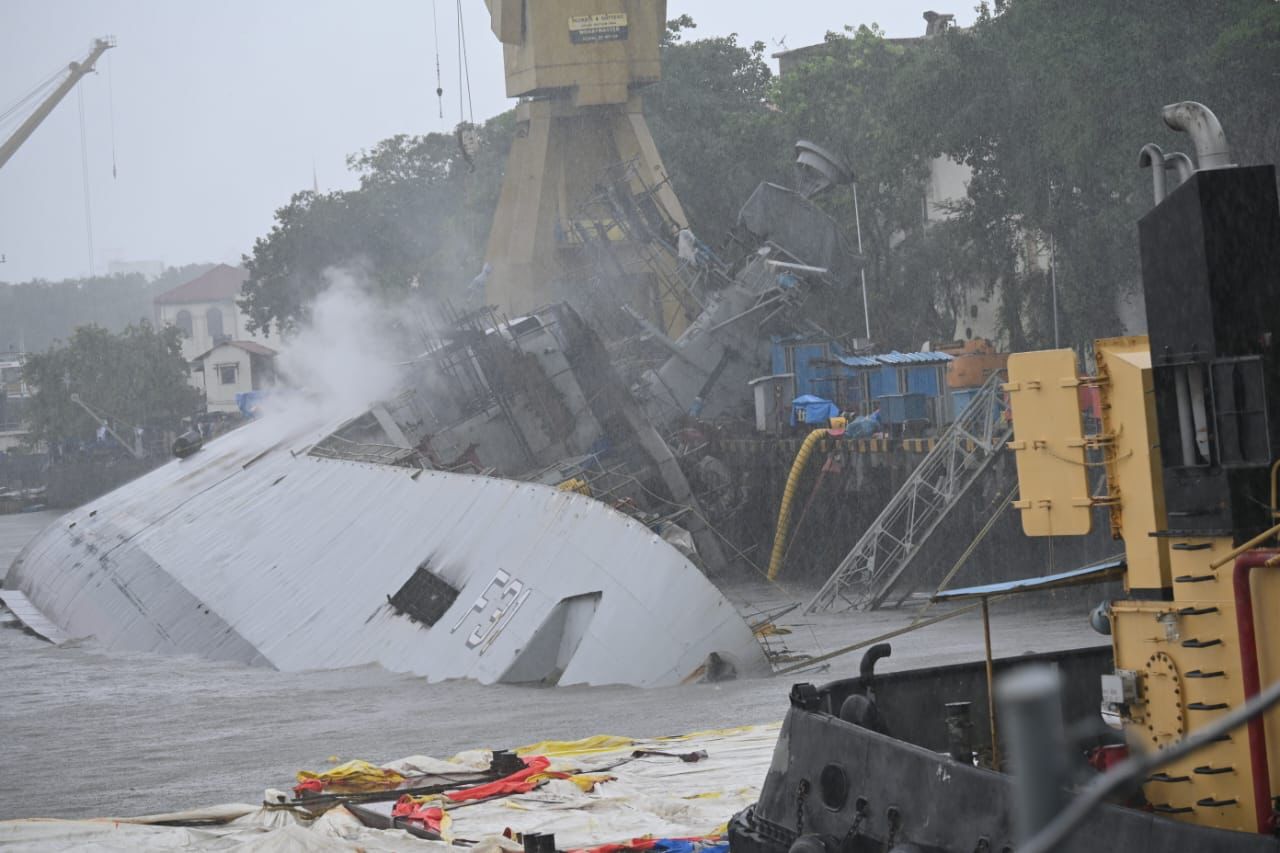A tragedy that recently struck an Indian Navy warship, the INS Brahmaputra, has raised eyebrows about mounting cases of mishaps during peacetime.
A devastating fire erupted on the INS Brahmaputra on July 21, inflicting significant damage and causing the vessel to list. The fire reportedly broke out while the vessel was undergoing refit and maintenance work at a dockyard in Mumbai.
“In the fire incident onboard the frigate INS Brahmaputra, the warship experienced severe listing to one side (port side). Despite all efforts, the ship could not be brought to an upright position. The ship continued to list further alongside her berth and is presently resting on one side,” the Indian Navy said in a statement.
All personnel have been accounted for except one junior sailor, for whom the search was launched immediately after the fire. The EurAsian Times recently published a detailed report on the incident and its possible cause, which can be read here.
INS Brahmaputra: Ex-Submariner Explains What Could Have Gone Wrong With Indian Navy’s Warship
The incident highlights serious doubts about the Indian Navy’s operational readiness and safety protocols, given the troubling trend of accidents and mishaps. For example, a 2017 audit report presented to Parliament revealed that the Indian Navy recorded 38 incidents involving ships and submarines from 2007 to 2016.

A Comptroller and Auditor General (CAG) examined several naval mishaps that occurred over nine years and published a report in 2016 stating that 39% of the accidents were caused by fire, explosion, or flooding. It did not stop there. In 2017, a massive tragedy struck the Indian Navy when INS Arihant was crippled because someone left “a hatch open.”
EurAsian Times revisits the incident involving India’s leading submarine, launched on this day in 2009 by former Prime Minister Manmohan Singh, coinciding with the anniversary of Vijay Diwas (Kargil War Victory Day).
Nuke Submarine Accident
INS Arihant, designated S2 Strategic Strike Nuclear Submarine, is the lead ship of India’s Arihant class of nuclear-powered ballistic missile submarines.
The initial submarine in a series of five, INS Arihant, was constructed under the Indian Navy’s secret Advanced Technology Vessel (ATV) initiative. INS Arihant plays a crucial role in achieving India’s nuclear triad and functions as the nation’s strategic strike nuclear submarine.
A report published in January 2018 in the Indian publication The Hindu revealed that the nuclear submarine was put out of operation in 2017 after an aft hatch was left open by someone while the submarine was docked.
According to accounts from naval officials mentioned by various Indian media outlets, an open hatch on the rear left side of the Arihant allowed seawater to enter the propulsion section while the submarine was docked. As a result, the Arihant had to be decommissioned for ten months to repair the pipes and drain out the water.
At that time, it was thought that pipes subjected to highly corrosive seawater could not be relied upon to function again, particularly those meant for transporting pressurized water coolant to and from the ship’s 83-megawatt nuclear reactor. Further, the damaged pipes posed a risk to both the crew and the nuclear weapons onboard the vessel.
So, several pipes, which include the ones that transport pressurized water coolant to and from the ship’s 83-megawatt nuclear reactor had to be removed and replaced due to the extreme corrosiveness of seawater. At the docks, the six-thousand-ton INS Arihant remained out of commission while the pipes were fixed and the water was pumped out. The entire process took ten months.
The extensive repairs proved costly for the Indian Navy, creating an alarming situation for the first nuclear-powered submarine, which had already incurred a service cost of nearly $3 billion.
This unfortunate incident led to backlash for the service, with observers saying it was embarrassing and unbelievable that a careless human mistake could render a nuclear submarine inoperable.
Arihant is based on the Russian Akula-1 class nuclear attack submarine, which was lengthened to accommodate 12 K-15 short-range nuclear missiles or four K-4 intermediate-range nuclear missiles.
However, while the incident was still causing ripples within the ranks of the Indian Navy, some reports stated that “it raised more questions than it gave answers” despite the elaborate explanation of the accident reported initially.

A controversy broke out as media reports and naval analysts flagged that the submarine did not have hatches. The Arihant is modeled after a double-hulled, sealed nuclear reactor vessel from Russia. No other nation with nuclear submarines has this system, except the most recent French nuclear submarines, which feature a hatch above the reactor, enabling speedier refueling.
At that time, Economic Times noted, “There are no external hatches in the compartment that houses the steam turbine, gearbox, generator and shaft that drives the propeller. Under normal circumstances, it is not possible for seawater to enter the submarine, and certainly not via a ‘non-existent hatch.’ It is also not possible for a modern submarine that has various sensors to not have a warning system about an open hatch in any other area of the submarine critical for its survival.”
Some reports published in the aftermath of the incident noted that India attempted to hide the accident and that the absence of the INS Arihant was first noted in 2017 during the Doklam standoff with China. The reports said it was only in early 2018 that the Indian military admitted that the submarine had indeed undergone repairs.
Some analysts dismissed these assertions, like the one about the hatch, as dubious. Moreover, the Government of India (GoI) did not explain the incident or the various conspiracy theories circulating.
When probed over the accident in the Parliament, the then-Minister of State (MoS) for Defence, Subhash Bhamre, said, “The information cannot be divulged on the floor of the House in the interest of National Security.”
INS Arihant is undeniably a crucial component of India’s nuclear capability against its adversaries. In 2018, the sub completed its first 20-day deterrent patrol.
Such is the secrecy around INS Arihant that no naval officer, serving or retired, on-record or off-record, agreed to share their inputs with the EurAsian Times about the accident.
The incident on board the Arihant happened soon after INS Chakra, a Nerpa-class nuclear submarine leased from Russia, was reported to have suffered damage to its sonar domes while entering the Visakhapatnam harbor in October 2017.
However, INS Chakra has only a training and escorting role in the nuclear triad. INS Arihant is supposed to carry nuclear missiles.
- Contact the author at sakshi.tiwari9555 (at) gmail.com
- Follow EurAsian Times on Google News




